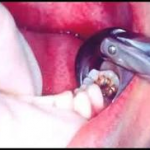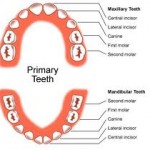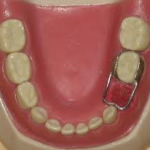When a practitioner is faced with enforced extraction of a primary tooth it is often a dilemma whether to merely remove the unsaveable tooth , to extract a contralateral tooth from the same arch (balance), or to extract a tooth from the opposing arch (compensation). The following guidelines are intended to assist in making such a decision and to minimise the effect of space loss on the developing dentition. There have been no properly controlled prospective randomised studies into the consequences of early loss of primary teeth, probably due to the difficulty of recruiting subjects for such studies and the need to follow them for up to 10 years. The recommendations given are therefore based partly upon current clinical opinion, although this is supported where possible by the best available research data. There is a need for more research in the area.
 Consideration must always be given to the overall dental health and history of the child, which may over-ride purely orthodontic advice.
Consideration must always be given to the overall dental health and history of the child, which may over-ride purely orthodontic advice.
 1. Definitions
 1.1 Balance enforced extractions
A balancing extraction is a tooth from the opposite side of the same arch, designed to minimise centreline shift.
 1.2 Compensate enforced extractions
Compensation means extraction of a tooth from the opposing quadrant to the enforced extraction. It is designed to minimise occlusal interferance by allowing teeth to maintain occlusal relationships as they drift. It is more difficult to justify compensation than balance, especially when it would involve removal of a tooth from an intact arch.
2. Recommendations
2.1 Radiographic screening is highly desirable before extracting primary molars to check for the presence, position and correct formation of the crowns and roots of  successional teeth. Potential problems indicate the need to seek an orthodontic opinion before teeth are removed.
2.2 Loss of primary incisors – Early loss of primary incisors has little effect upon the permanent dentition although it does detract from appearance. It is not necessary to balance or compensate the loss of a primary incisor.
2.3 Loss of primary canines and first molars – Early loss of a primary canine in all but spaced dentitions is likely to have most effect on centre lines. The more crowded the dentition, the more the need for balance.
With regard to a primary first molar, a balancing extraction may be needed in a crowded arch. Compensation is not needed. In the event that unbalanced extraction of a primary canine or first molar has already occurred, one of three situations will apply.
• No centreline shift. Do not balance.
• Centreline shift with complete space closure. Delay balancing until a full orthodontic assessment is made.
• Centreline shift with spacing remaining mesial to the extraction site. Monitor to determine whether tooth movement is continuing: if so seek orthodontic advice.
2.4 Loss of primary second molars – There is no need to balance the loss of a primary second molar because this will have no appreciable effect on centreline coincidence. However this extraction may allow serious forward movement and tilting of the adjacent first permanent molar. Therefore when a primary second molar has to be extracted consideration should be given to fitting a space maintainer.
2.5 Space maintainer – A tooth is the ideal space maintainer and every effort should be made to retain primary molars until the proper time for their natural loss. The decision to fit a space maintainer after enforced extraction must be arrived at by balancing the occlusal disturbance that may result if one is not used against the plaque accumulation and caries that the appliance may cause and poor oral hygiene is a contraindication. Space maintenance is most valuable in two situations.
• Loss of a primary first molar where crowding is severe, i.e. more than 3.5mm (half a unit) per quadrant. In this situation space loss due to drift may be so severe that the extraction of one premolar may be insufficient to relieve resultant crowding so that subsequent orthodontic treatment is more difficult.
• Loss of a primary second molar, except in spaced arches.
2.5.1 Types of space maintainer
A tooth – even badly decayed primary molars can often be restored for a few years.
Band and loop – the design of choice for a single tooth space.
Lingual or palatal arch – best for bilateral spaces. Studies have shown a lingual arch to be very effective for maintaining arch perimeter.
Upper removable appliance – avoid unless the appliance can be used also for active orthodontic treatment.
Explanatory Notes
1. Normal Occlusal Development
 1.1 The teeth of the first dentition are sometimes described as temporary or deciduous teeth, to be shed like the leaves of a tree and therefore of only passing importance. This is incorrect and short-sighted since the primary teeth, have a vital role to play in maintaining the dimensions and form of the dental arches during eruption of the permanent dentition.
1.1 The teeth of the first dentition are sometimes described as temporary or deciduous teeth, to be shed like the leaves of a tree and therefore of only passing importance. This is incorrect and short-sighted since the primary teeth, have a vital role to play in maintaining the dimensions and form of the dental arches during eruption of the permanent dentition.
1.2 The primary dentition
There is much natural variation in occlusal development. However three features indicative of good development are incisor spacing, anthropoid spaces mesial to the maxillary primary canines and distal to the mandibular caninesand straight or mesial step primary second molar occlusion.
1.3 First permanent molar eruption
Class I molar relationship is the basis upon which a fully intercuspated Class I occlusion is built. Development of Class 1 occlusion depends on the primary molars remaining in position until the correct time so that unwanted movements of permanent teeth are prevented.

